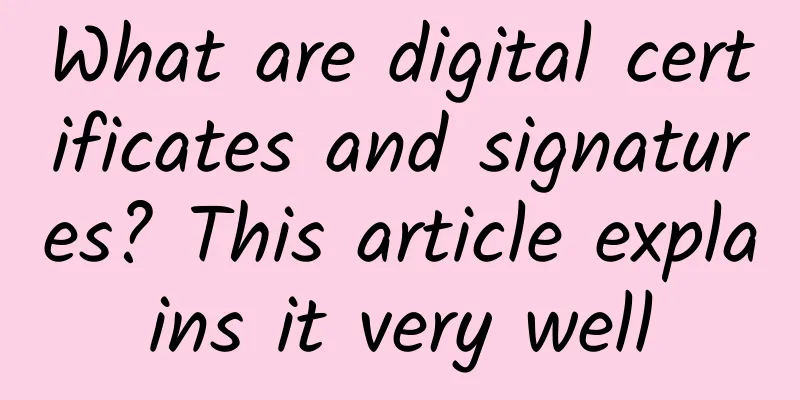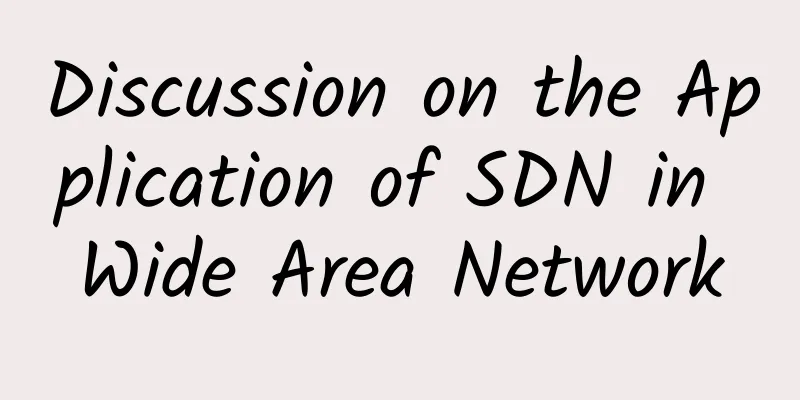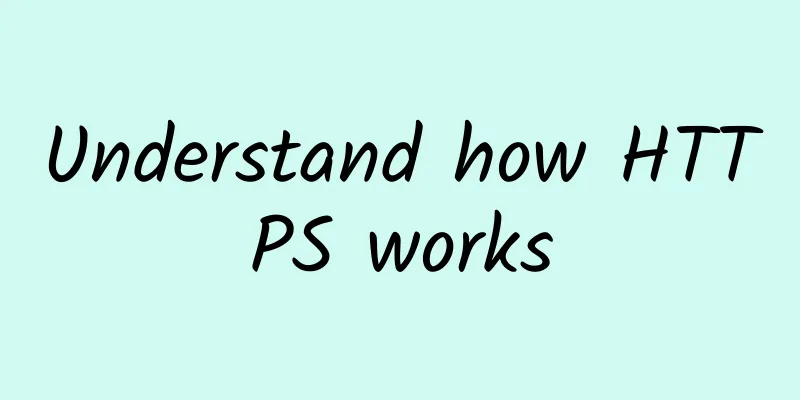What are digital certificates and signatures? This article explains it very well

|
Hello everyone, I am Brother Ming. I sorted out some content about digital certificates and digital signatures some time ago, and I’m going to post it today. We all know that HTTP protocol transmits content in plain text. In order to ensure the security of data transmission, HTTPS protocol came into being. However, it is not a new protocol, but the HTTP protocol plus SSL/TLS protocol. Therefore, when you visit a website that supports https, you need to first perform an SSL/TLS handshake to establish a connection.
The purpose of the SSL/TLS handshake is to securely negotiate a symmetric encryption key. With this key, all subsequent data will be encrypted using this key. This process is actually quite interesting, and involves many knowledge points and professional terms, such as symmetric encryption, asymmetric encryption, message digest, digital signature, digital certificate, public key and private key. This article will introduce these professional terms that are easily confused in detail. Before I explain, I will ask you a few basic questions. If you are not able to answer them skillfully, this article will give you the answers:
1. Symmetric encryption and asymmetric encryption (1) Symmetric encryption Symmetric encryption is a communication method in which both parties share a key. This key can encrypt plaintext into ciphertext, and decrypt ciphertext into plaintext. Common symmetric encryption algorithms include AES, DES, and RC4, among which AES is the most commonly used. The advantages of symmetric encryption are: fast speed. At the same time, there is also a disadvantage, which is that it is not so safe. Once your key is stolen by others, all your data will be exposed in the world of the Internet. (2) Asymmetric encryption The opposite of symmetric encryption is asymmetric encryption. The communicating parties hold different keys. The server's key is called a private key, and the client's key is called a public key. The difference between them is:
A typical asymmetric encryption algorithm is RSA. The advantage of asymmetric encryption is that it has a very high security factor. The disadvantage is that it is slower. (3) Combination of symmetric and asymmetric encryption When the public key received by the client is accurate, the communication is secure. Because the ciphertext encrypted with the correct public key can only be decrypted by the server's private key. So how do we ensure that the client receives the correct public key? The answer is: use asymmetric encryption to negotiate the symmetric encryption key. Once the server securely sends the correct public key to the client, in subsequent communications, symmetric encryption is used to encrypt data to ensure efficient communication. The specific process will be explained in more detail later. 2. What are digest, signature and certificate? (1) Information summary A piece of information, after being processed by a digest algorithm, gets a string of hash values, which is called the digest. Common digest algorithms include MD5, SHA1, SHA256, SHA512, etc. There are a few things you need to understand about the abstract:
(2) Digital Signature After the summary is encrypted with the private key, it has a new name - digital signature.
So what is the significance of understanding digital signatures? Just answer the following two questions. The first question is, if we have a message digest, why do we need a digital signature? Answer: Although the message digest is also irreversible, it can be easily forged. Therefore, the message digest is only used to verify the integrity. To ensure the correctness of the message digest, you must rely on digital signatures. The signing and verification of digital signatures are asymmetric encryption, and others cannot forge them unless they get the private key. The second question is why not encrypt the content directly, but encrypt the summary instead. Answer: From the above we know that asymmetric encryption is very slow. If the amount of data transmitted is very large, the time for encryption and decryption will be much longer than the network transmission time, which will be counterproductive. If we only require integrity of the transmitted content, but not security (it doesn't matter if the transmitted content is known by others), we can encrypt the digest, decrypt it on the client side to get the digest plaintext, and then compare this digest plaintext with the digest calculated by the second calculation of the transmitted data. If they are consistent, it means that the transmitted content is complete and has not been tampered with. (3) Digital Certificate Have you found a problem with digital signature? Digital signature is asymmetric encryption. The server has a private key and the client has a public key. Only when these two match can the signature be verified. What if the public key you (the client) get is not given by the server, but given to you by a hacker? And you treat this fake public key as the real one. Then when you use this fake public key to encrypt some sensitive information, the hacker can intercept your information, because this information is encrypted with the hacker's own public key. In this way, the hacker can use his own private key to decrypt and obtain your sensitive information. That's the problem. To solve this problem, you only need to ensure that the "public key" is credible. You can only use the public key sent to you by the server, and you must know how to identify and discard the public key given to you by the bad guys. Digital certificates came into being. To understand digital certificates, you only need to understand two questions.
To help you understand this process, I drew the following picture:
3. Digital Certificate In the transmission process of HTTPS, there is a very critical role - digital certificate. What is a digital certificate? What is its function? A digital certificate is an identification mechanism used in computers. The signature (stamp) made by a digital certificate authority (CA) on a signature request file created using a private key indicates that the CA structure recognizes the certificate holder. (1) Digital certificates have the following advantages:
(2) Certificate Type There are two types of x509 certificate encoding formats: PEM (Privacy-enhanced Electronic Mail) is in plain text format, starting with -----BEGIN CERTIFICATE----- and ending with -----END CERTIFICATE-----. The content in the middle is base64-encoded. The certificate required by Apache is this type of encoded certificate. The command to view the information of this type of certificate is: openssl x509 -noout -text -in server.pem. In fact, PEM is a base64 encoding of the content of DER. DER is a binary certificate. The command to view the information of this type of certificate is: openssl x509 -noout -text -inform der -in server.der (3) Extension
(4) Types of certificates Security certificates are mainly divided into three types: DV, OV and EV, and the corresponding security levels are general, good and highest. The review process, review standards and corresponding number of domain names of the three are also different, so the prices range from one or two hundred yuan to tens of thousands of yuan. DV SSL: A DV SSL certificate is a simple (Class 1) SSL certificate that only verifies the domain name ownership of a website. It can be issued quickly within 10 minutes and can encrypt transmission, but it cannot prove the true identity of the website to users. Currently, all free certificates on the market are of this type, which only provide data encryption but do not verify the identity of the individuals and institutions providing the certificates. OV SSL: OV SSL provides encryption functions, conducts strict identity verification on applicants, and provides credible ××× certificates. The difference between OV SSL and DV SSL is that OV SSL provides an audit of individuals or organizations, can confirm the identity of the other party, and is more secure. Therefore, this part of the certificate application is charged~ EV SSL: EV = The most secure and strict EV SSL certificate follows the globally unified and strict identity authentication standards and is currently the industry's top-level (Class 4) SSL certificate with the highest security level. Financial securities, banks, third-party payments, online shopping malls, etc., websites that emphasize website security and corporate credibility, involving transaction payments, customer privacy information, and the transmission of account passwords. This part has the highest verification requirements and the most expensive application fee. When choosing an issuing agency, it is best to choose a certificate issued by a CA agency that is recognized by the industry and can be used worldwide. At present, there are not many certificates in our country that meet the standards. The main reason is that some certificates cannot be recognized by foreign browsers and require certain additional operations when used. According to the number of protected domain names, SSL certificates are divided into:
(5) Where is the certificate? When you download and install a browser, the browser actually has certificates from globally recognized root certificate authorities embedded inside it. If the certificate authority that issued the digital certificate for a website is not available in the browser, users will need to be guided to import it themselves. If you want to see which certificate authorities are trusted in Chrome, you can click Settings -> Privacy and Security -> Security -> Manage Certificates (6) Information in the certificate In the location in the above picture, double-click on any certificate to view the contents of the certificate. There is a lot of content, the most important of which are
(7) Certificate revocation A certificate has a life cycle. If the private key of a certificate is leaked, the certificate must be revoked. There are generally two ways to revoke the certificate: CRL and OCSP. CRL (Certificate Revocation List) is a list of revoked certificate serial numbers maintained by the CA. The browser needs to update this list regularly. When verifying the legitimacy of the certificate, the browser will also check whether it has been revoked in the certificate revocation list. If it has been revoked, the certificate is also untrustworthy. It can be seen that this list will increase with the increase of revoked certificates, and the list will become larger and larger. The browser also needs to update it regularly, and the real-time performance is also relatively poor. Therefore, OCSP (Online Certificate Status Protocol) was created to solve the problem of the growing size of CRL lists and poor real-time performance. With this protocol, browsers no longer need to update CRLs regularly. When verifying certificates, they can directly check in real time with the CA server to see if the certificate has been revoked. This solves the CRL problem, but it is very slow to check with the CA server every time. When the network environment is poor or when accessing across borders, the experience is very poor. Although OCSP solves the CRL problem, its performance is very poor. 4. How to generate a CSR file CSR is the abbreviation of Certificate Signing Request, which is a certificate signing request file. When an applicant applies for a digital certificate, the CSP (Cryptographic Service Provider) generates a private key and a CSR file. After the applicant submits the CSR file to the Certificate Authority (CA), the CA signs it with its root certificate private key, thus generating a digital certificate. The applicant applies for a digital certificate from the CA through the CSR file. After obtaining the certificate, it can be proved that the applicant's website is credible and the data transmission is encrypted. Next, let’s take a look at how the CSR file is generated. (1) Generate using OpenSSL Assume that the domain name applied is python.iswbm.com, the company name is Paison Time Technology, the department is IT, and the company is located in Shenzhen, Guangdong, China. You can generate a CSR file by running the following command line:
This command line means:
subj parameter description:
After the previous command is executed, two files will be generated in your local directory:
(2) Use online generation tools The method of using OpenSSL tools to generate CSR files is simple, but when using it, you need to understand the meaning of the parameters in the code. If you don't want to remember all of this, I recommend you use the CSR online generator (https://myssl.com/csr_create.html) You just need to enter the following information and click OpenSSL Generate, and you will get an OpenSSL command. Now you don't have to piece together the parameters yourself. It's really convenient. Why not click Generate to let it generate the private key file and CSR file directly? Of course, it's for security reasons. 5. TLS/SSL ensures information security In information security issues, we often have to do three things to ensure the security of information:
Combining these three is what TLS/SSL does.
The above uses asymmetric encryption (CA's public key and private key), which ensures that the client receives the correct public key from the server. With the server's public key, subsequent information encryption can use this public key. The ciphertext encrypted with this public key can only be decrypted by the server's private key, and even if a hacker gets it, he cannot decrypt it. |
<<: If operators want to make profits, they should eliminate 4G packages first.
>>: Getting started with SD-WAN, just read this article
Recommend
Nine 5G trends to watch in 2021
Research firm Omdia believes that several 5G tren...
Discussion on the Application of SDN in Wide Area Network
Internet industry application trends and problems...
India issues 5G trial license, but won't use Chinese network technology
The decision to exclude the Chinese manufacturer ...
Gartner predicts that global spending on 5G network infrastructure will double by 2020
[[336113]] Recently, according to Gartner's l...
These core Internet protocols are gradually changing
The Internet we are familiar with used to mainly ...
What exactly are we talking about when we talk about AI? The answer is in Huawei's "Friends Circle" on March 21!
[51CTO.com original article] The topic of AI has ...
iWebFusion: Los Angeles and other 5 data center servers starting from $49/month, E3-1230v3/16GB/250G SSD/10TB/IPv4+IPv6
iWebFusion (iWFHosting) is a subsidiary of H4Y, a...
RackNerd: $12.79/year KVM-1GB/20GB/3TB/Los Angeles data center
Recently, RackNerd has restocked a low-cost annua...
Enterprises need to have six capabilities to achieve digital transformation
As we step into the 21st century, the wave of dig...
Mobile layout: Do you enter from a single point or start with the platform?
Mobility has become a standard feature of enterpr...
Cancel data "roaming" fees: speed, accuracy, and transformation, none of them can be lost!
In this year's government work report, the &q...
AI identification and root cause location of 5G wireless problems help improve network quality
Author: Zhang Zhe and Chen Juanjuan, unit: Hebei ...
The live streaming of selling goods is so smooth, it turns out that this technical system is supporting it!
1. Introduction Hi, everyone. I am your Xiaomi. T...
Omdia: In the third quarter of 2020, 109 commercial 5G networks were launched worldwide
On October 28, according to the latest 5G service...
Do you know all the things you need to pay attention to when using threads?
[[344283]] This article is reprinted from the WeC...

![[Black Friday] HostDare: 15% off Los Angeles CN2 GIA line VPS, starting at $42.4 per year](/upload/images/67cac21ee8bfc.webp)







